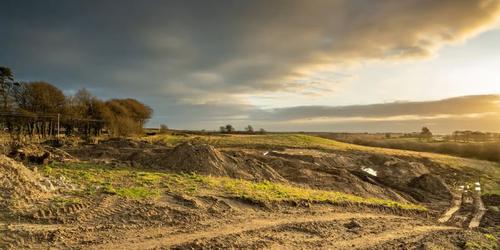Tucson takes no backseat in golf options, variety and fun
There's a little bit of everything for everybody here in the Sonoran Desert
By Steve Habel
When it comes to golf in Arizona, Tucson is not usually the first place that comes to mind.
But that's a big mistake, as the Grand Canyon State's second largest city and metro area is home to some of the nation's most striking, beguiling, and challenging courses, with a little bit of anything for every level of golfer in a place one can play golf about 350 days a year.
The Sonoran Desert, a place where every color in the spectrum collides to create dramatic vistas and beauty, dominates region. The sands feature spectacular cacti - including the giant saguaro, a symbol of the American Southwest. Mountain ranges in surround the area and produce high-desert tests for golfers.
There are more than 40 courses throughout the region, providing players with endless options - be it desert, mountain or parkland golf courses.
On a recent trip to the area, we played five courses in three days and left Tucson wowed by the variety of golf we enjoyed, all on pristine tracks. We found that once you immerse yourself in the laid-back atmosphere of Tucson, you may never want to leave.
Our first stop, literally right off the airplane, was the Sewailo Golf Club at Casino Del Sol, about a 15-minute drive west of the airport. Opened in 2013, it's Tucson's newest course. Designed by Ty Butler and Notah Begay and home to more than 40,000 native plants and 14 acres of lakes, the course is built into the natural desert landscape.
It has been recognized as one of Arizona's top courses since the day it opened for play, and it didn't take long to figure out why.
Sewailo Golf Club, which plays to a par of 72 and at 7,283 yards from its back set of five tees, features arroyos and streams with elevation changes, and natural hazards coming into play. Smooth yet undulating putting surface welcome approach shots, and the course is more parkland than typical Arizona target golf thanks to the Yaqui tribe's access to the Central Arizona Project water.
There is no doubt that the front-nine, which measures about 200 yards shorter than the back, is the easier side and will produce chances for birdies and confidence building.
You will need it on the back, which begins with the course's most-talked-about hole, the double-dogleg 638-yard par 5 10th and is followed by a murderer's row of tests - namely the 504-yard par-4 11th, the 242-yard par-3 13th, and the 584-yard par-5 14th.
Sewailo is definitely a golf course where you must think about your shot, gather information and place the ball in the correct spot. It's every bit as spectacular and difficult as you might have heard and was a fitting course to set the table for the rest of our trip.
After the round at Sewailo, we hightailed it across town to the Ventana Canyon Golf & Racquet Club and had just enough time to play the Mountain Course, one of two Tom Fazio-designed tracks on the property.
The golf experience at Ventana Canyon, set against the backdrop of the Santa Catalina Mountains, offers a unique blend of challenge and playability. Both the Mountain and the Canyon courses meander from one unique hole to another. Four sets of tees allow each player to test his or her ability on a well-marked and manicured course.
The Mountain Course features one of the most photographed holes in the West, the short par-3 third tucked into the rugged rocks of the mountains and played across a canyon of cacti. The tee offers a breathtaking panorama that stretches across the desert into Mexico.
Ventana Canyon's Mountain Course takes advantage of plenty of elevation changes and desert terrain. Playing from five sets of tees, the longest of which are carded at 6,907 yards.
And while so many people consider the aforementioned third hole the highlight of the course, I much preferred the stretch that followed. Beginning with the par-5 fourth, the short par-4 fifth and the par-4 seventh, which asks for a lengthy carry over desert landscape and ends with a putting surface protected on both sides by deep sand.
Although it is shorter, the Mountain Course is more difficult than the Canyon course, as nearly every tee on the course forces a desert carry and the fairways tend to be narrow and offer uneven lies. The beauty of the mountain background and the desert can be both distracting and intimidating, especially from the back tees.
I've played a lot, and I mean a lot, of Fazio courses, and I have to say that the Mountain Course might be my favorite. It's a quintessential members/resort course, rewarding great shots and confident approaches to the greens and steely nerves. There's a reason that these two spectacular courses are on nearly every list of the nation's very best.
Ventana Canyon also was my home-away-from-home for the trip, as I slept each night in a plush bed in an expansive suite at the 50-unit Lodge at Ventana Canyon, which was originally built for the club's private membership. The club still has exclusive rights on one of the courses each day, meaning in order to play both, you need to spend two days at the resort - nice work if you can get it.
Day two on the trip was spend playing the two 18-hole tracks at the Omni Tucson National Resort - the Catalina Course, routed, designed and nurtured by the architecture team of Robert Van Hagge and Bruce Devlin and open for play since 1965, and the Sonoran Course, fashioned out of the desert some 40 years later by Tom Lehman.
Tucson National's two golf courses present the starkest contrast between two ideals, with the former a manicured, traditional parkland-style track and the latter a more scruffy, target-golf course on far more harsh, rugged desert landscape. The Catalina Course rolls across the landscape on flatter land, while the Sonoran Course heads up into the desert.
The Catalina, named for the mountain that looms above it, has hosted more than 30 PGA Tour events and is now the home of the Cologuard Classic, a PGA Tour Champions Tour event played each March.
The challenges here are the corridors lined by tall trees, the demanding greens complexes, 80 bunkers, and eight lakes. The 18th hole on Catalina, stretching 443 yards and uphill between two of those lakes, is considered one of the toughest finishing holes in the world
In all likelihood, your ball won't find its way under a cactus on the Catalina Course. Rest assured, there are plenty of chances to get up close and personal with the desert's signature Saguaros and desert plant life on the newer Sonoran Course.
It's an up-and-down test, with plenty of carries over the desert waste areas, tree-lined bunkers, pristine vegetation and gentle contours. The Sonoran Course plays at less than 6,700 yards but requires precision to keep the ball in play.
Sonoran has two large lakes and 69 strategically placed bunkers to deal with. Players can approach each hole in a variety of ways, keeping the course challenging and unique with each new round.
Of the two courses at Tucson National. I favored the Catalina. It's a very fair, and balanced layout and I especially like the variety of the par 5s - some are tight and short, others are wide open and long; and the balance of the par 3s in yardages (though three of them are in the same direction). It's a little bit of everything, with some holes over water, others uphill, some long and some short.
The final day of the trip was spent at the tougher-than-nails JW Marriott Starr Pass Golf Club,
the former home of the PGA Tour's Tucson Open. Starr Pass is home to three nine-hole courses: Roadrunner, Coyote, and Rattler, and all three enjoy dramatic views of surrounding mountain ranges and impressive elevation changes and present a nice mix of challenging and easier holes.
Former PGA Tour Commissioner Deane Beman, inspired by the natural beauty and rugged terrain on this site 10 miles west of downtown Tucson, selected Starr Pass as a tour site when he saw the land for the first time.
The late Bob Cupp and Craig Stadler designed the golf course as a Tournament Players Club (TPC) facility in 1986. The tour players struggled here on the Coyote and Rattler nines, so it's easy to understand how regular, non-super-human golfers fared.
In 2004, the course was mitigated by Arnold Palmer and his design associate Ed Seay, with some of the severe slopes on the greens softened and the deep bunkers made a little easier to escape. There wasn't a lot done tee to greens, except making the elevation changes a little less dramatic.
Most first-time players are pleasantly surprised that the course is so much in the mountains. They think it is going to be desert flat, but it is far from that.
When you get to Starr Pass, take with you the knowledge that this track was designed to be a challenge for the best players in the world. Just the round one shot at a time and understand you are going to take some lumps on this course - but it's certainly worth it, even if just for the views, the serenity, and the understanding that you've taken the challenge.
I played the Rattler/Roadrunner combination, and everything was outstanding from tee to green. Every hole was a treat in itself, and there were no weak offerings. It helped that I played with two guys who were familiar with Starr Pass and had played it before. It's very important to play from the right tees (I played from the Silver tees and I'm playing to a 5 handicap these days, as there are many forced carries both from the tee and into many of the greens.
I truly enjoyed the round and would consider it a must play when in the Tucson area.
If you haven't considered Tucson as a prime contender for your next golf trip, well, then you are missing the boat.
Revised: 08/30/2018 - Article Viewed 18,172 Times
About: Steve Habel
![]() Steve Habel is a contributing editor for GolfTrips and its associated websites. A 26-year industry veteran, he regularly contributes to various regional, national and international golf publications and has played and written about more than 1,600 golf courses around the world.
Steve Habel is a contributing editor for GolfTrips and its associated websites. A 26-year industry veteran, he regularly contributes to various regional, national and international golf publications and has played and written about more than 1,600 golf courses around the world.
Habel is also senior editor for Horns Illustrated magazine, a publication focusing on University of Texas sports, as well the San Antonio Spurs beat writer for The Sports Xchange. He is a correspondent for the Austin American-Statesman and frequently files stories and features for The Associated Press and Preferred Lifestyle magazine.
Habel, who lives in the Austin, Texas area, has worked media coordinator for World Golf Hall of Fame player and golf architect Tom Kite as well as for renowned golf architects Roy Bechtol and Jeffrey D. Brauer.
He is a member of the Golf Writers Association of America, the Texas Golf Writers Association and the Football Writers Association of America.



















